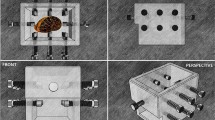Abstract
Experimentally induced shell repair in the land snailOtala lactea has been employed to study the influence of the substratum on microtopography of the surface of mineral deposited by molluscs. Substrata, including the periostraca of four species of molluscs, surface replicas, and the outer membrane of the eggshell of the hen, have been inserted in the area of shell repair inOtala, and the topographical patterns of deposition of calcium carbonate have been observed by scanning electron microscopy. The mineral patterns formed on all inserted substrata conformed to the microtopography of the surfaces and were distinctly different from that of normal shell regeneration. The topography of the normal outer mineral surface of the shell of four species of molluscs were observed to conform to the topography of the periostraca on which the crystalline shell is deposited. It is inferred that the topography of the outer mineral surface of the shell probably results from the interaction of crystals of aragonite and calcite growing in an organic matrix and in contact with the periostracum. Normal shell ofOtala consists of fine-grained aragonite in highly preferred orientation. Regenerated shell contains calcite grains in random orientation and aragonite, usually in random orientation. The aragonite-to-calcite ratio varies widely and appears to be independent of experimental substrata placed in the area of repair.
Résumé
Une régénération de la coquille induite expérimentalement chez l'excargot terrestreOtala lactea a été utilisée pour l'étude du substratum sur le type de régénération minérale. Des subsrats, comportant le periostracum de quatre espèces de mollusques, des répliques de surfaces et la membrane externe de la coquille de poule, ont été insérés au niveau de la région de reconstitution de la coquilled'Otala. Les divers types de dépôt de carbonate de calcium sont étudiés en microscopie électronique par balayage. Les types minéraux, formés sur les substrats mis en place, se conforment à la microtopographie des surfaces et se trouvent être nettement différents du type minéral observé au cours d'une régénération normale de la coquille. Les types minéraux de la surface minérale externe normale de la coquille de quatre espèces de mollusques semblent identiques aux types individuels de surface du periostracum sur lequel les cristaux de la coquille se déposent. Il semble que ce type de surface minérale externe de la coquille se forme par l'interaction de cristaux de CaCO3 qui se développent dans une matrice organique au contact du periostracum. La coquille normaled'Otala est constituée d'aragonite à orientation hautement préférentielle. La coquille régénérée contient de la calcite et de l'aragonite orientées au hasard. Le rapport aragonite-calcite est très variable et parait indépendant des substrats expérimentaux placés dans la région de régénération.
Zusammenfassung
Der Einfluß der Unterlage auf die Art der Mineral-Neubildung im Gehäuse der Landschnecke,Otala lactea, wurde mit dem Raster-Elektronenmikroskop untersucht, indem in der Regenerationszone Fremdkörper eingeschoben wurden. Diese Fremdkörper waren Periostraca von vier anderen Molluskenarten, Plastikabdrücke von Periostraca oder der äußeren Mineral-Oberfläche normaler Gehäuse und die äußere Membran einer Hühnereierschale. Die Oberflächenstruktur des Kalziumkarbonats, das auf diesen Unterlagen abgelagert wurde, entsprach der Mikrotopographie der Unterlags-Oberfläche und war deutlich verschieden von der Mineraloberflächenstruktur bei normaler Regenerierung des Gehäuses.
Die Strukturen der normalen Mineraloberflächen der vier Molluskenarten entsprachen der Struktur der Periostracum-Oberfläche, auf welcher die Kalziumkarbonat-Kristalle abgelagert werden. Die Mineraloberflächenstruktur des Gehäuses ergibt sich vermutlich durch die Wechselwirkung zwischen den Kalziumkarbonat-Kristallen, welche in einer organischen Matrix wachsen und der Berührung mit dem Periostracum.
Das normale Mineral von Otala-Gehäusen besteht aus Aragonit in ganz bestimmter Anordnung. Regeneriertes Gehäuse enthielt Kalzit in zufälliger Anordnung und Aragonit, meist auch in zufälliger Anordnung. Das Verhältnis Aragonit/Kalzit variierte stark und schien unabhängig von der experimentellen Unterlage zu sein.
Similar content being viewed by others
References
Bøggild, O. B.: The shell structure of mollusks. Kgl. Danske Videnskab. Selskabs, Skr. Naturvidenskab. math. Afdel.2, 232–235 (1930)
D'Attilio, A., Radwin, G. E.: The intritacalx, an undescribed shell layer in mollsuks. Veliger13, 344–347 (1971)
Fujii, S. H., Tamura, T.: Scanning electron microscopy of the hen's egg shell. J. Fac. Fisheries and Animal Husbandry8, 85–98 (1969)
Hamilton, G. H.: The taxonomic significance and theoretical origin of surface patterns on a newly discovered bivalve shell layer, the mosaicostracum. Veliger11, 185–194 (1969)
Kessel, E.: Über die Schale von Viviparus viviparus L. und Viviparus fasciatus Müll. Ein Beitrag zum Strukturproblem der Gasteropodenschale. Z. Morph. Ökol. Tiere27, 129–198 (1933)
Meenakshi, V. R., Blackwelder, P. L., Wilbur, K. M.: An ultrastructural study of shell regeneration inMytilus edulis. J. Zool.171, 475–484 (1973)
Saleuddin, A. S. M., Wilbur, K. M.: Shell regeneration inHelix pomatia. Canad. J. Zool.47, 51–53 (1969)
Taylor, J. D., Kennedy, W. J.: The influence of the periostracum on the shell structure of bivalve molluscs. Calcif. Tiss. Res.3, 274–283 (1969)
Taylor, J. D., Kennedy, W. J., Hall, A.: The shell structure and mineralogy of the Bivalvia Introduction. Nuculacea-Trigonacea. Bull. Brit. Mus. (Nat. Hist.) Zool., Suppl.3, 1–125 (1969)
Tsujii, T., Sharp, D. G., Wilbur, K. M.: Studies on shell formation. VII. The submicroscopic structure of the shell of the oysterCrassostrea varginica. T. biophys. biochem. Cytol.4, 275–280 (1958)
Wada, K.: Crystal growth of molluscan shell. Bull. nat. Pearl Res. Lab.7, 703–828 (1961)
Satabe, N., Sharp, D. G., Wilbur, K. M.: Studies on shell formation. VIII. Electron microscopy of crystal growth of the nacreous layer of the oysterCrassostrea virginica. J. biophys. biochem. Cytol.4, 281–286 (1958)
Wilbur, K. M.: Shell formation in mollusks. In: Chemical Zoology (M. Florkin and B. T. Scheer, eds.), p. 103–145. New York-London: Academic Press 1972
Wilbur, K. M.: Mineral regeneration in echinoderms and molluscs. In: Hard Tissue Growth, Repair and Remineralization. Ciba Foundation Symposium 11 (new series), p. 7–33. Amsterdam: Elsevier, Excerpta Medica, North Holland 1973
Wilbur, K. M., Watabe, N.: Experimental studies on calcification in molluscs and the algaCoccolithus huxleyi. Ann. N.Y. Acad. Sci.109, 82–112 (1963)
Author information
Authors and Affiliations
Rights and permissions
About this article
Cite this article
Meenakshi, V.R., Donnay, G., Blackwelder, P.L. et al. The influence of substrata on calcification patterns in molluscan shell. Calc. Tis Res. 15, 31–44 (1974). https://doi.org/10.1007/BF02059041
Received:
Accepted:
Issue Date:
DOI: https://doi.org/10.1007/BF02059041



